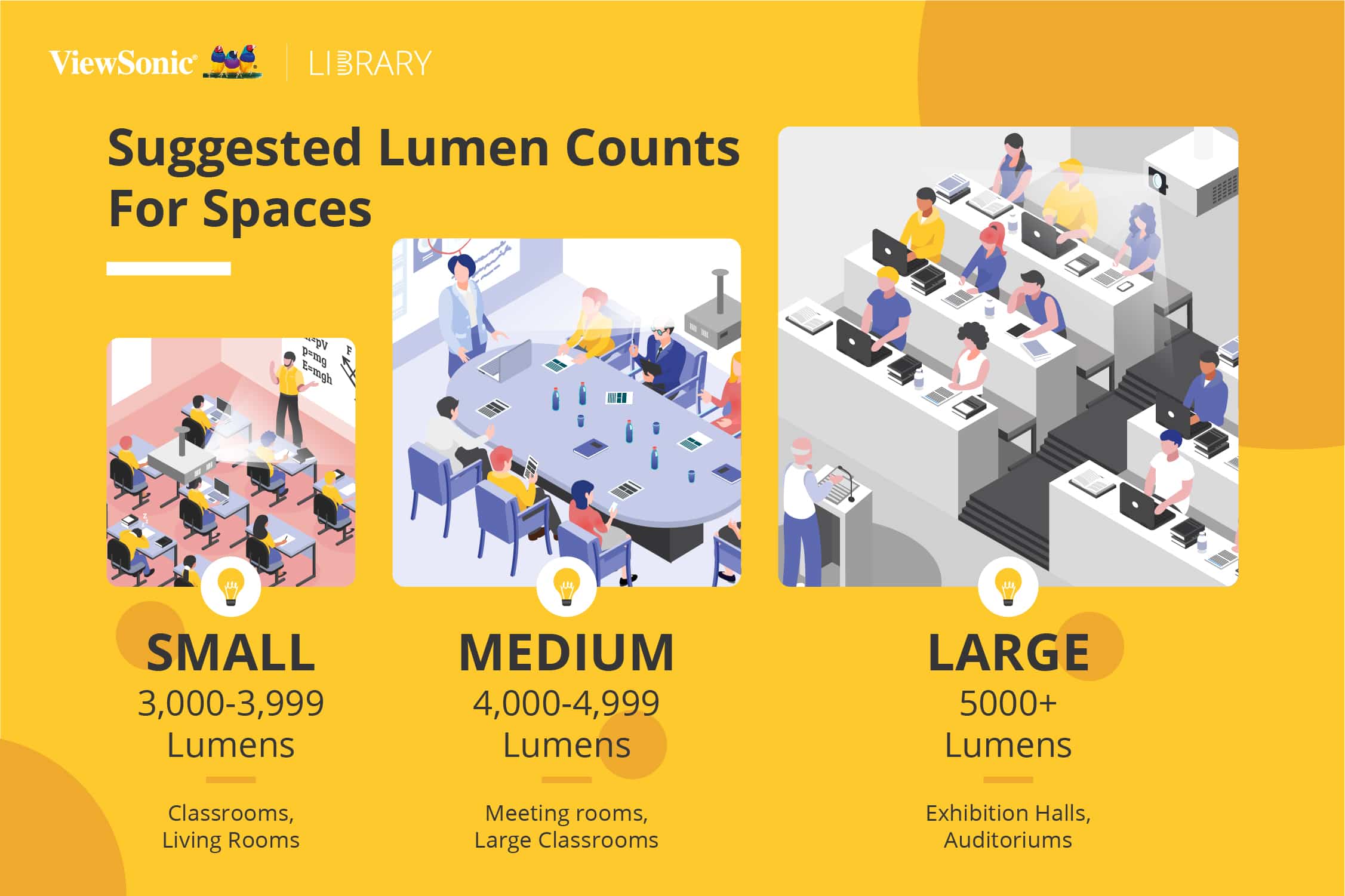When shopping for a projector, one of the most frequently encountered terms is lumens. But what exactly are lumens, and why are they so important? Officially called ANSI lumens, this measurement indicates the brightness of a light source, which is crucial for determining how well a projector will perform in different environments.
Keep reading to learn about the concept of projector lumens or explore ViewSonic projectors to find the best one for you.
When you’re evaluating projectors for your home or business, it’s easy to become overwhelmed with the terminology associated with the devices. While projector resolution receives much attention, the lumen value is another crucial factor to consider.
What are Projector Lumens?
Lumens, usually indicated as “ANSI Lumens” (American National Standards Institute lumens) as the industry-standard measurement, determine the brightness level of a projector’s light source.
Projectors use three types of light sources: lamp, LED, and laser. Lamp projectors usually offer higher initial brightness, typically starting at 2,000 ANSI Lumens, but require periodic lamp replacements and experience brightness degradation over time. In contrast, lamp-free projectors, such as LED and laser models, provide consistent brightness throughout their longer lifespan, with laser projectors exceeding 3,500 ANSI Lumens and LEDs offering superior color saturation and efficiency despite lower lumen counts.
To give you a better idea, here are the lumen counts of common light sources:
- 100-watt light bulb: 1600 lumens
- Fluorescent lighting in office: 400 lumens
- Lighting on a movie set: 1000 lumens
- Sunny day: up to 100,000 lumens
Why Do Projector Lumens Matter?
Lumens measurement is crucial for devices like projectors, where brightness directly affects image quality and visibility in various environments. The higher the lumens count, usually the brighter the light is.
The concept of lumens is tailored to match how the human eye perceives light, making it a practical standard for comparing different light sources. However, when evaluating the brightness of modern wide color gamut projectors with LED and RGB laser light sources, it’s important to note that ANSI brightness ratings alone may not accurately reflect their true performance. This is due to the Helmholtz-Kohlrausch (HK) effect, where highly saturated images appear brighter than less saturated ones.

What Brightness Level Best Suits Your Needs?
Selecting a projector isn’t as simple as choosing the highest lumen count. There’s no one-size-fits-all solution, as several factors influence the required brightness level for a quality picture.
Factors Affecting Projector Brightness
Ambient Light
Consider the amount of natural or artificial light in the room where you’ll be projecting content. For example, natural light from windows can reduce the visibility of the projected image. In brighter environments, you’ll need a projector with higher lumens to prevent the image from washing out.
Screen Size
The size of the projection screen can influence how bright the image appears. Larger screens typically require projectors with higher lumens to maintain a clear and vibrant image.
Room Size & Distance from Screen
The size of the room plays a significant role in determining the required lumens. Larger rooms need higher lumens to ensure even brightness distribution across a broader viewing area. Additionally, the arrangement of seating and the distance from the screen can influence how well viewers perceive the projected content. Adequate lumens are essential to ensure everyone in the audience has a clear and enjoyable view.
Projectors for Home
Home entertainment projectors rated under 3,000 ANSI Lumens are typically sufficient for daily use. This brightness level can easily project an 80” image with minimal distortion, though controlling ambient light is crucial.For larger images or rooms with more ambient light, higher lumen projectors are necessary.
Under 3,000 ANSI Lumens: Best for better color performance but requires tight control of ambient light.
Above 3,000 ANSI Lumens: Less sensitive to ambient light, ideal for larger images.
Projectors for Business and Education
To address the diverse requirements of both business and education, specific lumen thresholds come into play when selecting projectors for business and education settings.
Different settings require different ANSI lumen thresholds:
-
Smaller Settings (1-10 people)
For meeting rooms or classrooms, 3,000-3,999 ANSI lumens are ideal. This setting easily projects an 80”+ screen size, at a value price point. It’s best only to use projectors with these lumen levels when ambient light is minimal.

-
Medium Settings (10-50 people)
For mid-sized meeting rooms or classrooms, 4,000-4,999 ANSI lumens provide high-quality images of 80”+, but the higher brightness means that the user doesn’t have to worry as much about ambient light.

-
Large Spaces (more than 50 people)
For large meeting rooms, exhibition halls, or auditoriums, 5,000+ ANSI lumens are suitable for handling high levels and projecting images 100” or larger. The power of these projectors means they work well even with high levels of ambient light.

Final Thoughts
Although projectors are relatively simple to use, choosing the best one to fit your needs is a bit more difficult. When it comes to striking a balance between value and performance, you need to consider how and where your projector will be used.
If you plan to use the device outdoors or in a room with much ambient light, then a high lumen count is essential. The same applies to situations where you’re using a projector in a large space, and/or require a larger screen size.
However, if you’re looking for a budget-conscious solution, choosing a projector with fewer lumens is practical if you use it in a setting where ambient light can be controlled, and space of small to medium size.
Still need guidance in choosing the right projector? Dive into our article on choosing the ideal office projector or commercial projector for digital signage.
Or explore the range of ViewSonic projectors to find the one that perfectly matches your needs.

Was this article helpful?
YesNo